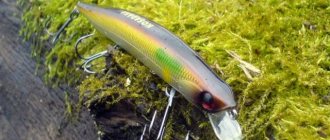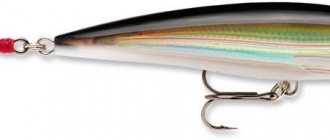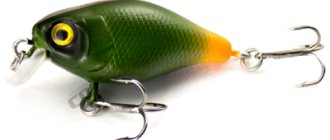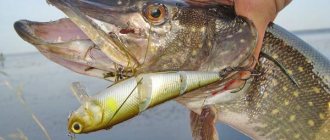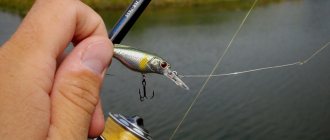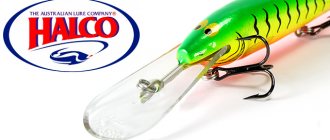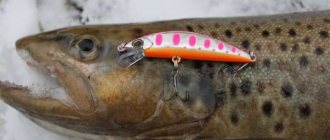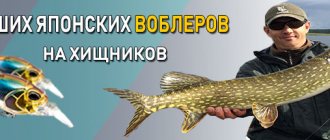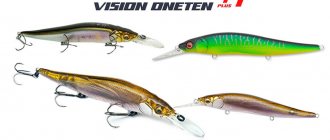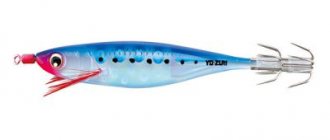Minnow
– one of the main types of wobblers according to a classification that takes into account the shape (geometry) of the wobbler, along with shads, fats and cranks. Wobblers of this type are deservedly enjoying unprecedented popularity among anglers, and deservedly so, since they are among the most effective. Today there is hardly a fisherman who has not seen this type of wobbler, but not everyone knows the terminology and understands the nuances of using this wonderful type of bait.
Features of minnow wobblers
Minnow wobblers
Among all bladed classic wobblers, there are usually three main groups: fat, shad and
minnow .
The names reflect the shape or shape of the lures. These are thick, medium and narrow wobblers, respectively. There are an incredible number of transitional options, since it is impossible to draw a clear line separating groups 1 and 2 or groups 2 and 3 by type. Therefore, a clear and structured definition of the class of minnow baits is unlikely to be achieved, but we will try. Let us define the main characteristic features of the class of minnow baits:
- The body length of a wobbler refers to the height of the bait from five to one or more.
- The shape of the bait varies between slightly curved (convex upward) and cigar-shaped.
- The blade is small, set at an angle of forty-five degrees to the body of the bait. The blade area is much smaller than the maximum possible cross-sectional area of a wobbler.
- The buoyancy of such a wobbler is approximately neutral, that is, the bait is weakly floating, weakly sinking or suspended.
Classification
Classic wobblers Minnow
Traditional minnow-shaped wobblers have a rounded, elongated body, with a slightly convex back, noticeably tapering towards the tail. The approximate ratio of length to body height of the wobbler is 5:1. At the bottom of the head part of the body there is a blade, the size and angle of which determines the working depth of the wobbler and its play. Minnow wobblers are equipped, mainly with two or three tees, depending on the size of the bait.
Deep Sea Minnow
Deepwater Minnow There are also many models with a larger blade. Here, when choosing a wobbler, you need to take into account the fact that not all large-blade wobblers can be used for casting fishing. Basically, models 10-12 centimeters long, with shovels of various sizes, are used for fishing at depths of up to three meters. These wobblers are distinguished by the size of their blades, the size of which determines the immersion depth of the wobbler (in this case we are talking only about floating models). A large blade also creates much greater resistance when jerking, so the rod, when used in fishing with such wobblers, must be more powerful and rigid. It is advisable to know the exact speed of ascent of the wobbler, this is necessary so that during pauses when the wobbler begins to emerge, one can know exactly the depth at which the minnow is currently located. It is during pauses, when the wobbler, depending on its buoyancy, either floats or sinks, or hangs in the water column (the most consistently tempting predator option), and most of the bites occur. Therefore, it is important to know all the parameters of the wobbler in order to successfully use them under various fishing conditions.
Minnow members
Another fairly common type of minnow wobblers is minnow-joints. The most popular, frequently encountered options are baits consisting of two parts (it should be noted that there are both three- and four-part minnow wobblers), which have the English name Jointed. These wobblers, almost all models, have a very active game and can be successfully used with even wiring. But it’s not for nothing that on some packages of these baits there is an inscription: “Jointed Minnow Walking Dog”, which says everything - what type of wobbler is in front of you and how exactly it is best to use it.
Mini Minnow
And the last variety of minnow wobblers, which is worth talking about in more detail, is mini-minnow or, as they are affectionately called “minoshki”. These are baits from the Lite and Ultra Lite categories and require special attention to themselves and their use. The Lite and UL classes usually include wobblers no longer than five centimeters. You should also pay attention to the fact that it is not so easy to find such babies on the shelves of our stores. The fact is that many manufacturers, especially Americans, produce mini-wobblers “fat” in large quantities, but the choice of mini-minnow clearly leaves much to be desired. The Japanese have the same picture; the most famous companies produce, with rare exceptions, only one or two models of “minos”. The main purpose of these kids is small rivers, fishing for trout, chub, and ide. We must pay tribute: ultralight fishing is exciting, exciting, enchanting, incomparably more laborious than fishing with a middle-class spinning rod.
There is, however, one problem: the fact is that mini-wobblers, especially Japanese ones, have very precise balancing. Floating models are valued because using them, you can fish spaces under the branches of bushes and trees hanging over the water, floating the wobbler to those places where it is simply not possible to throw bait.
Features of the game on wiring
When choosing a wobbler, it is important to pay attention to the size of the blade and its angle relative to the body of the bait - the working depth depends on this. Wobblers of the same size and shape with different blades are generally different baits, even the tackle may be different: it is not always possible to correctly cast a deep-sea copy of it with a spinning rod for twitching a “meterer”.
Minou wobblers of the above-mentioned classic shape have a very weakly expressed own game, but higher-bodied models, especially with a large blade, play quite well even with a uniform retrieve. Many models are used with equal success both for twitching and for stop-and-go fishing, even for trolling.
Sometimes during fishing it is possible and even necessary to diversify the bait retrieve by switching from twitching to stop-and-go, that is, to uniform with stops, but still most models, even those with their own game, most fully reveal their qualities when jerking.
Twitching is not only for minnows
Indeed, at first only “non-playing” models were twitched, because such animation suggested itself and no questions arose.
And playing wobblers attract fish quite well even with a steady retrieve, so there was no need to think about twitching with them. But over time, it became clear that all wobblers and not only them can be twitched. So, the first step from the classics was jerking shads . And it gave excellent results. The only thing is that jerks with them should be short and quite sharp.
fats came into play . True, these were mostly shallow-water versions, but still jerking thick short wobblers gave excellent results for perch.
Jerk retrieval of large wobblers-minnows and deep-sea minou
With the first ones everything is quite simple. The set of gear does not have certain features: a fast or ultra-fast spinning action and a reel with good laying. Only the test should be higher than for a 95-115 mm minnow. Thus, wobblers measuring 130-150 mm weigh approximately from 16 to 32 grams. It is clear that among the smaller ones there are heavyweights, but do not forget about frontal resistance: the larger the wobbler, the greater the resistance. The only exception is the jerk minnows of the marine pencil geometry series. Among them there are models up to 250 mm long, but they weigh the same as the smaller ones. However, due to their “slenderness,” they offer virtually no resistance in water.
The jerking of large wobblers looks the same as the wiring of smaller wobblers. That is, the jerk length will be approximately the same in the case of the 90 mm and 130 mm models. Only for the latter you need to pull a little harder to move it, giving a large initial acceleration.
At first glance, deep-water wobblers differ from shallow-water wobblers in that they have a blade and slightly greater resistance for the same size. But in practice they behave somewhat differently. Therefore, there are two nuances that should be taken into account before jerking deep-sea wobblers.
- A twitching rod should have a soft tip. At first glance, this contradicts the “laws” of jerk wiring, but here’s the thing. If you twitch a deep wobbler with a regular hard fishing rod, it will stray from the horizon and go significantly higher than its working level. In addition, only a soft tip will help you understand all the nuances of the deep’s behavior under water during wiring.
- After casting, it is necessary to make from three to ten revolutions of the reel at an average pace so that the wobbler reaches the specified depth and after that begin retrieving.
- The more aggressive the jerks, the closer to the surface the deep goes. But this feature sometimes helps. For example, in the case when a splash of pike was noticed at a casting distance in a shallow area. In order not to waste time replacing the bait, we simply throw the dip there. But in this case, the jerk drive must begin immediately after splashdown, and the drive must be aggressive. In this case, the rod tip should be kept higher. Thus, a deep-sea wobbler can be carried quite safely at a meter depth.
Video from an article about different types of wobbler wiring:
Despite the external similarity of minnow wobblers, the behavioral nuances of each of them are different. Therefore, it is worth paying more attention to the choice of jerk strength, amplitude and pause time. Thus, by constantly experimenting with a wobbler, you can understand all the features of its behavior and use them for your own purposes. And in this case, an unspoken rule applies: the closer to Japan the wobbler is made, the more detailed you need to approach its study. In practice, this means that it is not always possible to catch an expensive bait and only over time does it begin to work at full capacity. In this case, it would be a good idea to start mastering jerking with wobblers of inexpensive brands, since budget baits are easy to learn and master. And only then move on to more expensive models.
Minnow fishing
Fishing with a minnow Every fan of spinning fishing, who has even a little experience in fishing with wobblers, has in his arsenal and from time to time uses (and even catches a predator with them) this type of bait in practice. However, very few anglers can say with confidence that they are fluent in the technique of using this type of wobbler. It provides information that will help you master the intricacies of fishing with minnow wobblers.
Wiring
Most minnows have their own game. That is, on uniform wiring they play naturally and qualitatively. But it should be noted that such wiring does not always work as the fisherman would like. Stop and go wiring brings much better results. The essence of stop-and-go is that the spinner makes a soft pull with the rod. At the same time, the wobbler plays, then pauses. When there is a pause, depending on the form in which it is executed, sinking, floating or suspending, the bait begins to move or hang in one place. After a pause, a new stretch follows. Uneven movement significantly increases the number of fish bites on minnows. An even more effective wiring is twitching, in which jerks of varying strength and frequency are transmitted to the wobbler. The bait moves unevenly, sometimes chaotically, but the fish really like it. Reacts well to twitching wiring options.
Color
When an angler buys minnow wobblers in a store, he usually tries to take one model, but always in different colors. Usually it is fluorescent and natural. If we fish in the morning, when the light is low, when little light gets into the water, then fluorescent color options work much more effectively. They are visible to fish from a greater distance and often cause aggression in predatory fish. When the sun rises, a lot of light enters the water; when fishing takes place in clear water, wobblers of natural colors are more effective. Again, the day has ended or clouds have appeared in the sky, it has become dark, you can immediately put a brightly colored bait. Depending on the fishing conditions, colors must be alternated.
Depth
The working diving depth of the minnow is about 2.5 meters. It is to this depth that baits of this class, which have a relatively small blade placed at 45 degrees, can dive. The depth of penetration is determined by the size of the bait, the length and area of the nasal blade, and the angle of location. The most interesting thing is that if the minnow wobbler has a rattle, then even diving to a depth of 2.5 meters, it is capable of lifting predatory fish from a depth of about 5 meters. Don’t think that if the wobbler dives shallowly, it can only be effective in shallow water. In reality, rattling artificial baits lift fish from the depths. This must be taken into account when fishing. Of course, to generalize, minnows will undoubtedly work most effectively at depths of up to 3 meters.
Seasons
Modern minnow wobblers are very versatile baits. They allow you to effectively fish all year round, where open water is available. As a rule, suspensions work better in early spring. They work great in late fall and winter. If you fish in the summer, sinking baits or floating ones, which you cast quite quickly and energetically, perform much better. Among fishing lures, there are very few that are able to catch fish in a wide variety of fishing conditions.
Minnow slow sinking
Let's consider a method of feeding slow-sinking minnows to a predator. By and large, there is nothing super unusual in the technique of fishing with such wobblers, you need to remember only two main points: during a pause in the retrieve, slow sinking slowly sinks, and with continuous retrieve, it constantly strives to climb to the surface.
Regarding the first point: if under a moving wobbler there is a layer of clean water of sufficient thickness, then the length of the pauses does not particularly concern us, because if during a pause the wobbler drops below the wiring horizon by 20 - 30 cm, there will be no big grief. It’s a completely different matter if we fish at shallow depths, plus the bottom is covered with more or less densely growing algae or it is snagged - in this case we are forced to take minimal pauses in the retrieve to avoid possible snags.
There is one more nuance here: of two plunging slow sinking wobblers, the one whose volume is larger will sink slower, and this should always be taken into account when working with such baits.
According to the second point, i.e. according to the desire of a sinking wobbler to climb to the top: if you want to ensure that your bait moves constantly in the same horizon, plus or minus 10 cm, you must alternate the wiring with periodic pauses. It looks like this: the wobbler splashes down, let it dive to the required depth - and begin the retrieve, uniform or jerky - whatever you like.
The cord running at an angle from the bait gradually pulls the wobbler towards the surface, thereby forcing it to leave its working horizon - then we pause long enough for the wobbler to drop back to its original level - and continue wiring. The general rule is this: the longer the segment of continuous wiring (hence, the higher the wobbler rises up the inclined slope), the longer the pause should be, during which the bait will return to its original horizon.
Also, the duration of the pauses depends on the distance at which the bait is from the angler, especially when fishing from a boat - when fishing from the shore, this dependence manifests itself to a much lesser extent. When fishing with a boat, the closer to us the sinking wobbler that we are leading is, the stronger and at a more obtuse angle the cord pulls the bait to the surface.
Therefore, if we want to constantly lead the wobbler in the same horizon, then the closer the bait is to the boat, the longer pauses we need to make when lowering it - everything is quite simple.
Sinking minnows attract predators by “playing” not only during a forward retrieve, whether steady or jerky, but also during a fall—in this phase, many models sway their sides with one frequency or another. Sometimes this swaying is pronounced, if it occurs with great frequency, and resembles a kind of trembling.
Particularly distinguished by this are sinking minnows with flat side surfaces and a low center of gravity - such baits, especially small ones, literally mow down, for example, perch, and other predators do not refuse them either. Not only does such a minnow create vibrations that attract fish, it also glares on its sides, affecting the vision of the predator.
Slow-sinking minnows show themselves especially clearly during periods of cold water, say, in the fall, when predatory fish are more attracted to the “play” of the wobbler not in the horizontal plane, but in the vertical, i.e. slow dive during a pause in the wiring. And this dependence manifests itself not only in the fall, but also in any other period of the open water fishing season, and if, for example, the fish refuses to take a suspended suspender, then you should always try fishing with a sinking wobbler - this can give a good result.
Moreover, a predator’s bite can occur in any phase of the retrieve - during horizontal movement, during a fall, after a “twitch” has been performed, etc. - It will not be possible to trace any patterns in this, even with a strong desire.
Also, in reservoirs with standing water, slow sinking can be useful in situations where long-distance casting is required, especially when fishing is done from the shore - for example, if we want to put our bait under the overhanging branches of a tree on the opposite bank of a small river or bay or throw it to places of perch “fight”. Compared to exactly the same minnow-suspender, slow sinking will be heavier by only a couple of grams, but at a minimum, these grams will give an extra five meters to the casting distance, and sometimes just five to six meters and not enough to get to the fish.
Slow-sinking minnows are also good when fishing in windy weather, especially if you have to cast in strong side or head winds, because Thanks to the “extra” grams, it is easier for them to break through the air flow with a strong and biting cast along a flat trajectory.
It should be noted that there is one more very useful quality of bladed slow sinking minnows, which makes them somewhat universal in terms of such a parameter as the fishing horizon in shallow water: almost all wobblers of this type, even those with quite a significant mass, hold this same horizon very well. Let's say, a slow-sinking 15-gram bait can easily be cast at just half a meter depth.
The only thing is that you will need to make very minimal pauses in the retrieve or generally work with the wobbler at a continuous pace, keeping it in the required horizon. True, you also need to take into account the volume of the bait - with the same mass, a thin minnow with a narrow profile will sink at a higher speed - therefore, pauses in retrieving should be made as minimal as possible, literally in a split second. And, conversely, a voluminous wobbler having the same mass will sink more slowly due to the fact that the buoyant force will act on it more strongly.
